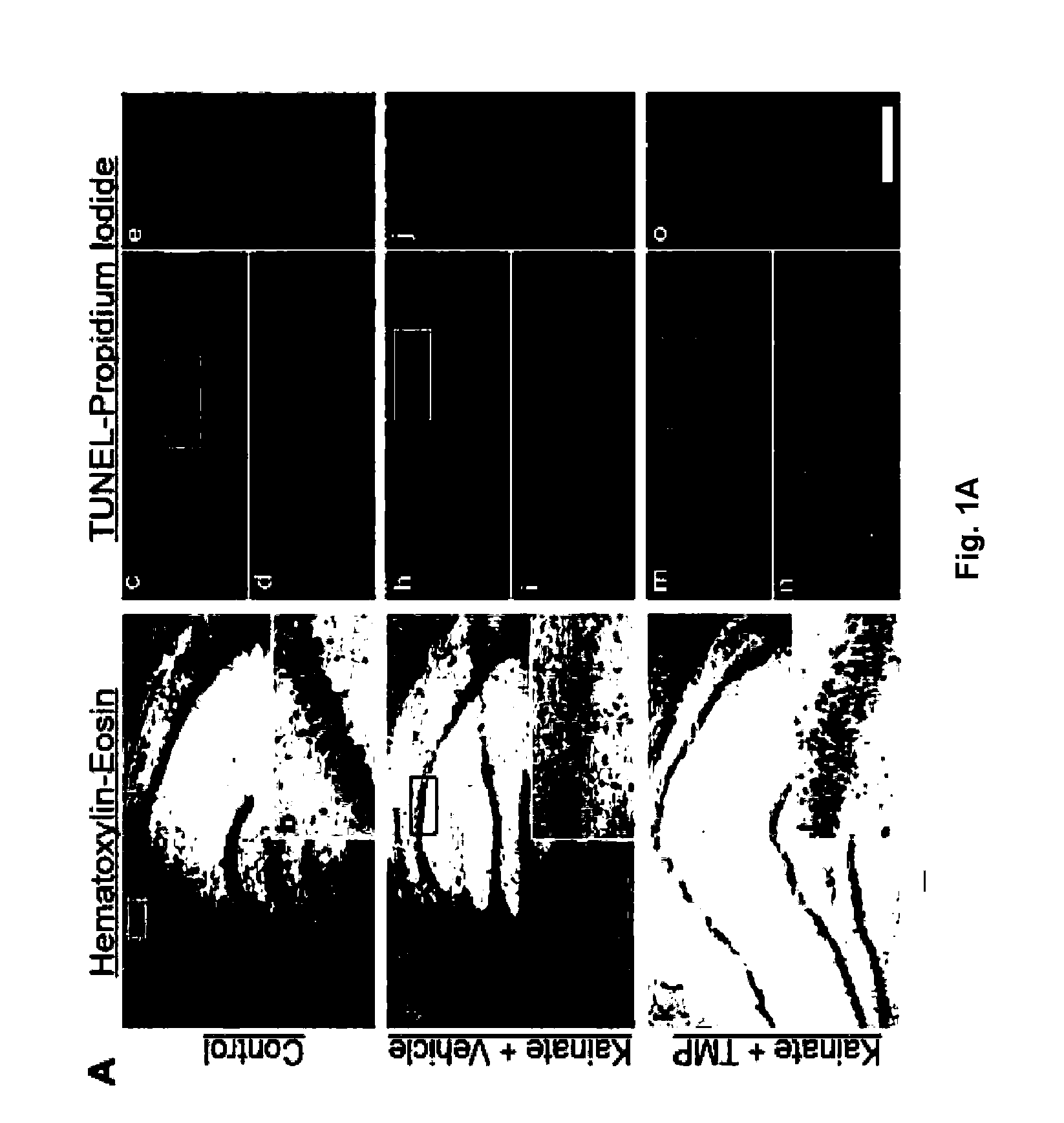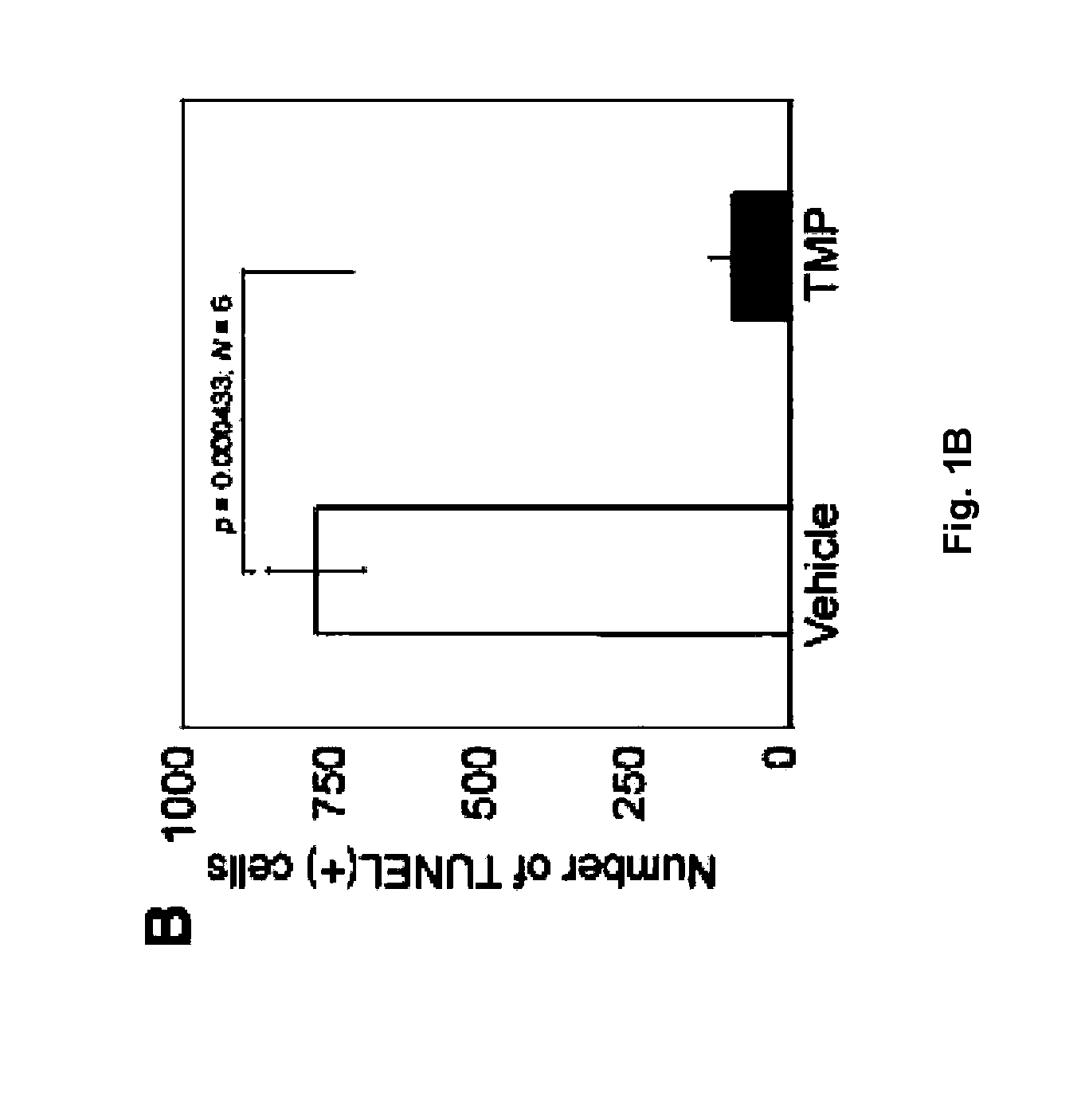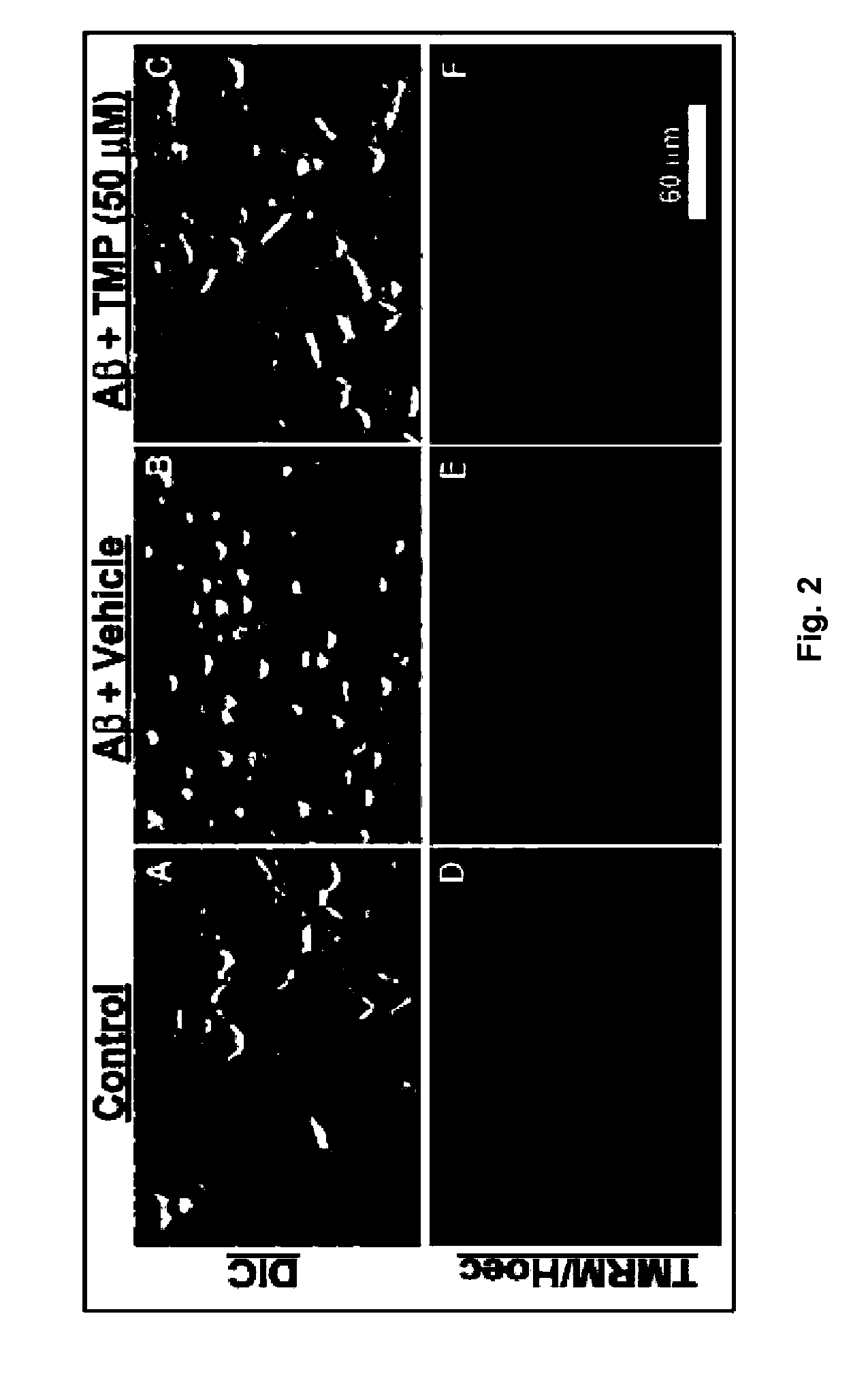[0012]The invention further relates to methods utilizing
retinal imaging to diagnose and monitor
efficacy of treating CNS disorders such as AD, PD, glaucoma, and HD, as well as TBI, by administrating an effective amount of a tetramethylpyrazine compound (e.g., TMP). In a particular embodiment, the invention relates to methods utilizing
retinal imaging to diagnose and monitor efficacy of treating AD, by administrating effective amounts of TMP. In accordance with the present invention, determining the presence of Aβ plaques and
amyloid angiopathy in the
retina of a patient may be used to diagnose and monitor efficacy of administration of TMP. A decrease in the presence of Aβ plaques in the
retina indicates that the TMP therapeutic
regimen is effective. An improvement in
amyloid angiopathy in the
retina indicates that the TMP therapeutic
regimen is effective. In accordance with the present invention, determining improvement in retinal
pathology, including a decrease in retinal thickness, indicates that the TMP therapeutic
regimen is effective.
[0015]In another specific embodiment, presented herein are methods for treating glaucoma in a patient in need of such treatment, comprising administering a therapeutically effective amount of a tetramethylpyrazine compound (e.g., TMP) to a patient with glaucoma. In a specific embodiment, presented herein is a method for treating glaucoma comprising administering a therapeutically effective amount of TMP to a patient with glaucoma, wherein the treatment prevents or reduces decreased
cerebrospinal fluid pressure. In another specific embodiment, presented herein is a method for treating glaucoma comprising administering a therapeutically effective amount of TMP to a patient with glaucoma, wherein the treatment prevents or reduces
ocular hypertension. In another specific embodiment, presented herein is a method for treating glaucoma comprising administering a therapeutically effective amount of TMP to a patient with glaucoma, wherein the treatment prevents or reduces the loss of
retinal ganglion cells. In another specific embodiment, presented herein is a method for treating glaucoma comprising administering a therapeutically effective amount of TMP to a patient with glaucoma, wherein the treatment prevents or reduces the neurodenegeration of
retinal ganglion cells. In another specific embodiment, presented herein is a method for treating glaucoma comprising administering a therapeutically effective amount of TMP to a patient with glaucoma, wherein the treatment prevents or reduces
atrophy of the
optic nerve. In another specific embodiment, presented herein is a method for treating glaucoma comprising administering a therapeutically effective amount of TMP to a patient with glaucoma, wherein the treatment prevents or reduces a loss in visual field. In another specific embodiment, presented herein is a method for treating glaucoma comprising administering a therapeutically effective amount of TMP to a patient with glaucoma, wherein the treatment prserves the visual field. In some embodiments, TMP is administered to the patient with glaucoma via eye drops. In other embodiments, TMP is administered to the patient with glaucoma as a topical ophthalmic solution.
[0018]As used herein, the term “therapeutically effective amount” in the context of administering TMP to a patient having or at risk of developing a
degenerative disorder of the CNS refers to the amount of TMP that results in a beneficial or
therapeutic effect. In specific embodiments, a “therapeutically effective amount” of TMP refers to an amount of TMP which is sufficient to achieve at least one, two, three, four or more of the following effects: (i) the reduction or amelioration of the severity of a
degenerative disease of the CNS and / or one or more symptoms associated therewith; (ii) the reduction in the duration of one or more symptoms associated with a
degenerative disease of the CNS; (iii) the prevention in the recurrence of a
degenerative disease of the CNS or one or more symptoms associated with a degenerative disease of the CNS; (iv) the regression of a degenerative disease of the CNS and / or one or more symptoms associated therewith; (v) the reduction in hospitalization of a patient having a degenerative disease of the CNS; (vi) the reduction in hospitalization length of a patient having a degenerative disease of the CNS; (vii) the increase in the survival of a patient having a degenerative disease of the CNS; (viii) the inhibition of the progression of a degenerative disease of the CNS and / or one or more symptoms associated therewith; (ix) the enhancement or improvement of the
therapeutic effect of another therapy; (x) a decrease in hospitalization rate of a patient having a degenerative disease of the CNS; (xi) the reduction in the number of symptoms associated with a degenerative disease of the CNS in a patient having a degenerative disease of the CNS; (xii) an increase in symptom-free survival of a patient having a degenerative disease of the CNS; (xiii) a reduction in the accumulation of
protein aggregates (e.g.,
amyloid plaques or neurofibrillary tangles (NFT)); (xiv) a reduction in inflammatory events associated with a degenerative disease of the CNS; (xv) a reduction in
cerebral amyloid angiopathy associated with a degenerative disease of the CNS; (xvi) a reduction in
oxidative stress associated with a degenerative disease of the CNS; (xvii) a reduction in mitochondrial stress associated with a degenerative disease of the CNS; (xviii) a reduction in
endoplasmic reticulum stress associated with a degenerative disease of the CNS; (xix) a reduction in the disruption of axonal transport associated with a degenerative disease of the CNS; (xx) a reduction in the loss of spines and / or synapses; (xxi) a reduction in
cholinergic dysfunction associated with a degenerative disease of the CNS; (xxii) a reduction in neuritic fragmentation associated with a degenerative disease of the CNS; (xxiii) a reduction in the loss of
estrogen associated with a degenerative disease of the CNS; (xxiv) a reduction in the loss of
neurotrophic factors associated with a degenerative disease of the CNS; and / or (xxv) a reduction in the loss of neurons associated with a degenerative disease of the CNS.
[0030]As used herein, the terms “treat,”“treatment,” and “treating” in the context of administration of TMP to a subject to treat a degenerative disease of the CNS, refer to a
therapeutic effect achieved following the administration of TMP or a combination TMP and one or more additional compounds or agents. In a specific embodiment, the therapeutic effect is at least one or more of the following effects resulting from the administration of TMP or a combination TMP and one or more additional compounds or agents: (i) the reduction or amelioration of the severity of a degenerative disease of the CNS and / or one or more symptoms associated therewith; (ii) the reduction in the duration of one or more symptoms associated with a degenerative disease of the CNS; (iii) the prevention in the recurrence of a degenerative disease of the CNS or one or more symptoms associated with a degenerative disease of the CNS; (iv) the regression of a degenerative disease of the CNS and / or one or more symptoms associated therewith; (v) the reduction in hospitalization of a patient having a degenerative disease of the CNS; (vi) the reduction in hospitalization length of a patient having a degenerative disease of the CNS; (vii) the increase in the survival of a patient having a degenerative disease of the CNS; (viii) the inhibition of the progression of a degenerative disease of the CNS and / or one or more symptoms associated therewith; (ix) the enhancement or improvement of the therapeutic effect of another therapy; (x) a decrease in hospitalization rate of a patient having a degenerative disease of the CNS; (xi) the reduction in the number of symptoms associated with a degenerative disease of the CNS in a patient having a degenerative disease of the CNS; (xii) an increase in symptom-free survival of a patient having a degenerative disease of the CNS; (xiii) a reduction in the accumulation of
protein aggregates (e.g., amyloid plaques or neurofibrillary tangles (NFT)); (xiv) a reduction in inflammatory events associated with a degenerative disease of the CNS; (xv) a reduction in
cerebral amyloid angiopathy associated with a degenerative disease of the CNS; (xvi) a reduction in
oxidative stress associated with a degenerative disease of the CNS; (xvii) a reduction in mitochondrial stress associated with a degenerative disease of the CNS; (xviii) a reduction in
endoplasmic reticulum stress associated with a degenerative disease of the CNS; (xix) a reduction in the disruption of axonal transport associated with a degenerative disease of the CNS; (xx) a reduction in the loss of spines and / or synapses; (xxi) a reduction in
cholinergic dysfunction associated with a degenerative disease of the CNS; (xxii) a reduction in neuritic fragmentation associated with a degenerative disease of the CNS; (xxiii) a reduction in the loss of
estrogen associated with a degenerative disease of the CNS; (xxiv) a reduction in the loss of
neurotrophic factors associated with a degenerative disease of the CNS; and / or (xxv) a reduction in the loss of neurons associated with a degenerative disease of the CNS.
 Login to View More
Login to View More 


